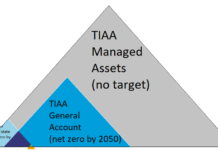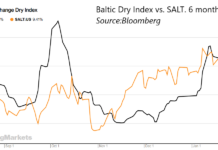Garvin Jabusch

Oil addiction photo via BigStock
|
You are drilling for oil and natural gas, and you probably don’t even know it. What, you say you’ve never been near a drilling rig, and aren’t even sure what one looks like? You’re still drilling, because companies you own are drilling.
Many financial advisors and asset managers routinely assume that broadly diversified stock portfolios will have holdings in fossil fuels companies. Even most stock mutual funds that identify themselves as ‘green’ funds contain natural gas and even oil holdings.
This is not only morally questionable, it’s also likely to lead to disappointing returns. If the goal of investing is to grow assets, accrue wealth, and prepare for our futures, then it’s key to invest in companies, industries and sectors that will still be there and growing in that future. Similarly, our collective macroeconomic goals shouldn’t be to keep the economy ticking along for the next quarter or current political term, but to keep it healthy so we may thrive for decades if not centuries. Fossil fuels companies fail on both these fronts: they face an uphill battle trying to grow into the medium and long term, and, for many reasons, they also hinder our chances of achieving economy-wide long-term economic growth, which limits your and my chances of positive portfolio returns.
We at Green Alpha believe that fossil fuels have no place in portfolios designed to capitalize on the emerging, sustainable, green, thriving next economy. We picture and model, rather, a next economy comprised of enterprises whose technologies, material inputs, and/or practices have not proven deleterious to the environmental underpinnings of the global economy; and, equally important, those whose businesses have a better than average probability of keeping economic production running close to capacity (meaning close to full employment and therefore causing sufficient economic demand to keep economies healthy). Healthy, innovative economies made up of healthy companies have always proven better for portfolio performance. Next economy companies are innovation leaders in all areas, not just in the energy industries; they exist now and will continue to emerge in all economic sectors, providing all products, goods and services required to have a fully functioning, even thriving global economy. And we believe that next economy companies will continue to win market share from legacy firms, and that they therefore provide superior odds of delivering long term competitive returns.
There are several key reasons this should be the case. As a global economy, we can no longer afford to wait for our basic economic underpinnings to break before we fix them. Too many issues, economy wide, from agriculture to water to warming, all damaged by fossil fuels, have been ignored and left to degrade. By now it’s clear that fossil fuels, including natural gas, do not result in us growing a thriving next economy. Between greenhouse gas emissions, toxic emissions (such as mercury), accidents, spills and contamination of soil, groundwater and oceans, to say they have proven deleterious to our environmental-macroeconomic underpinnings is an understatement. We need to make sure the earth’s basic systems – which global economies rely upon – keep on functioning. And the time to do that is now, while they’re still working.
Fortunately, as a global economy we are now (for the first time since the beginning of the industrial revolution) in a position to begin transitioning to methods that will allow us to run sustainably using advancements like far cheaper and more beneficial sources of energy. As inexpensive, unlimited renewables gain more market share, fossil fuels by definition will be losing market share, meaning stocks of companies providing the most economically competitive renewables will be in a better position to deliver superior stock performance than will oil, coal or even natural gas. Indeed, Shell Oil has recently projected that renewables will eclipse oil as society’s primary source of energy, making up as much as 40% of all energy used within the next 47 years. Considering the booming growth of renewables in recent years (particularly solar), I wouldn’t be surprised if this occurs much sooner; but in any case the writing is now officially on the wall. Fossil fuels have already begun to lose market share to renewables. In 2012, most new electricity generating capacity brought online in the United States was from renewables, and in January 2013, all new U.S. electrical generating capacity was provided by renewables. If these trends are even close to future outcomes, Shell’s prediction will have proven far too optimistic for the future of oil.
Further, from a stock valuation point of view it has also become clear that shares of fossil fuels companies have become far more risky as an asset class than they were even a few years ago. Most policy observers believe that within a few years there will be a worldwide price on carbon via some combination of carbon taxes, cap-and-trade schemes and/or requirements to sequester carbon via ‘capture and storage’ technologies. When these emerge in large ways, they will represent new systemic costs of business for fossil fuels companies that will potentially badly damage their margins. In addition, in a potentially more financially perilous risk, there is the ongoing specter incredibly expensive damage from accidents associated with fossil fuels. For example, look at BP’s management’s and shareholders’ objections to settlements and potential further judicially mandated costs and penalties relating to the 2010 Deepwater Horizon spill (above and beyond the $20 billion trust already established by BP). BP’s tortured arguments and huge efforts to avoid further financial liability for an accident for which they clearly are partially responsible reveals the devastating risks the oil industry will be facing as it reaches ever further for product. BP’s continuing potential liabilities from this one incident, including “uncapped class-action settlements with private plaintiffs” and “civil charges brought by the Justice Department” and “a gross negligence finding [that] could nearly quadruple the civil damages owed by BP under the Clean Water Act to $21 billion” among others, show, more than anything, that oil as an asset class is becoming a subprime investment.
All this being the case, why are fossil fuels companies’ stocks considered mandatory holdings by many professional money managers and investment banks? The primary answer is ‘modern portfolio theory;’ that body of knowledge regarding how to build diversified portfolios of stocks taught at MBA and finance departments all over the world and considered sacrosanct by most practitioners. There are good reasons modern portfolio theory (MPT) is so widely practiced, mainly that its underlying goal, to maximize return for a given level
of financial risk, is any portfolio manager’s ultimate duty. MPT asserts that the way to achieve this is to have appropriate portfolio exposure to various asset classes like cash, bonds, stocks, commodities, and from there to follow the proscribed allocation to specific sectors and industries within these groups in order to achieve the most “efficient frontier” mix of securities. The sectors proscribed by modern portfolio theory, as it is typically practiced, include fossil fuels such as oil and gas. But let’s recall that this theory was pioneered in the 1930s, and was considered more or less perfected by Harry Markowitz in the 1950s, culminating in his 1959 book “PORTFOLIO SELECTION EFFICIENT DIVERSIFICATION OF INVESTMENTS.” For Markowitz and his predecessors, fossil fuels were the only visible source of energy sufficient to power society, and by requiring portfolio allocations to these industries, they were effectively making sure investors got in on the profitable business of what was really the only energy available. Modern portfolio theory’s asset allocation models were made for and reflect a world where fossil fuels were the only imaginable primary power source. Moreover, in the 1950s, there were fewer material resource constraints, a far lower global population, the word ‘scarcity’ did not apply to the natural world, and no one had heard of climate change or global warming, so there really were no reasons to think twice about fossil fuels or to imagine reasons their returns could be at risk. But we don’t live in that world anymore.
Building a Fossil Fuels Free Portfolio
Next economy portfolio theory differs from MPT by recognizing that we live in an economy that no longer resembles the world of the 1950s. Where modern portfolio theory defines risk as financial risk only, next economy theory is also concerned with the risks of earth’s support systems failing. Where modern portfolio theory says to invest in oil and coal, then, next economy theory says to look for primary energy replacements that have not proven damaging to the environment to a degree where they disrupt economics and even society.
And in realizing that energy now means far more than it did in Markowitz’s day, and by observing that many if not all economic sectors from transportation to agriculture could be run in a sustainable fashion, largely using current technologies and approaches, we build portfolios comprised of next economy companies. This in turn helps the green economy to continue to accelerate, and provides clients with opportunity for competitive returns. Investing in the growing technologies of the future just makes better common sense than investing in the riskier, slowly shrinking technologies of the past.
Where modern portfolio theory says, ‘buy all these 1950s economic sectors,’ next economy theory says ‘look for all the ways there are to keep the economy going such that we, as a global economy, can thrive indefinitely.’ In that sense, we argue that current portfolio theory is upside down. So-called “Modern” Portfolio Theory is backward looking, but wise investors look forward. We must think very carefully about asset allocation in the modern economy, and start to make changes. Traditional asset classes must evolve (“critical power sources” rather than “oil and gas”, for example), and our portfolios must reflect that and begin to invest in fully functional enterprises that are both environmentally and economically sustainable far farther into our future than current MPT could foresee. But if MPT is all we know, how do we accomplish that? The only answer to that can be that we have to develop new processes. Green Alpha’s attempt at that, in some ways representing a reversal of traditional models of asset management, works like this:
- Begin at the highest macroeconomic and ecological levels and make an objective assessment regarding the most pressing issues confronting world economies
- Having identified key issues, the next step is to rigorously research scientific consensus and new approaches to the technologies, ideas and business practices best positioned to and most likely to successfully drive growth while aiding in mitigation of and/or adaptation of issues (such as climate change and resource scarcity)
- Of these approaches, then, we ask in the third step which can practically be deployed or practiced – that is, used in the real world
- Then, of these working, functional, practical approaches, we fourth ask which can also be aligned with economic interests such that they can attract market capital and inspire both entrepreneurs and established companies to engage. In other words, which can be deployed as profitable businesses
- Only now, at this point, do we in our fifth step identify specific companies that come as close as possible to meeting these criteria
- Looking at granular company-level financial data comes last for us, and is only applied to qualified next economy companies, as identified via the five-stage methodology above. In the final step then, we apply quantitative, rigorous, bottom-up financial analysis to identify stocks of next economy companies that offer the best financial positions with minimized risk, with particular focus on growth potential and market liquidity and bankruptcy risks.
The tools applied in the final step are universally known and practiced and do not bear describing here. And in any case this is not the piece of portfolio management we’re redefining. Suffice it to say that from a bottom up fundamental quant perspective, we don’t believe one can improve much Graham-Dodd valuation methodology.
Practicing this methodology, we arrive at innovative, fully diversified portfolios comprised of firms that are working now and are positioned to keep working far into the future as the next economy emerges to displace the fossil fuels economy.
As businesses advance the better, cheaper, more efficient technologies that do not result in further warming, increased resource scarcity, deadly pollution, and soil and groundwater contamination, we can only imagine the productivity, lifestyle and well-being surges that will be unleashed. So enough with traditional, oil based economic models.
We live in a new world, and it’s time we acted like it.
Garvin Jabusch is cofounder and chief investment officer of Green Alpha ® Advisors, LLC. He is co-manager of the Shelton Green Alpha Fund (NEXTX), of the Green Alpha ® Next Economy Index, and of the Sierra Club Green Alpha Portfolio. He also authors the Sierra Club’s green economics blog, “Green Alpha’s Next Economy.”








